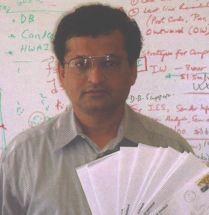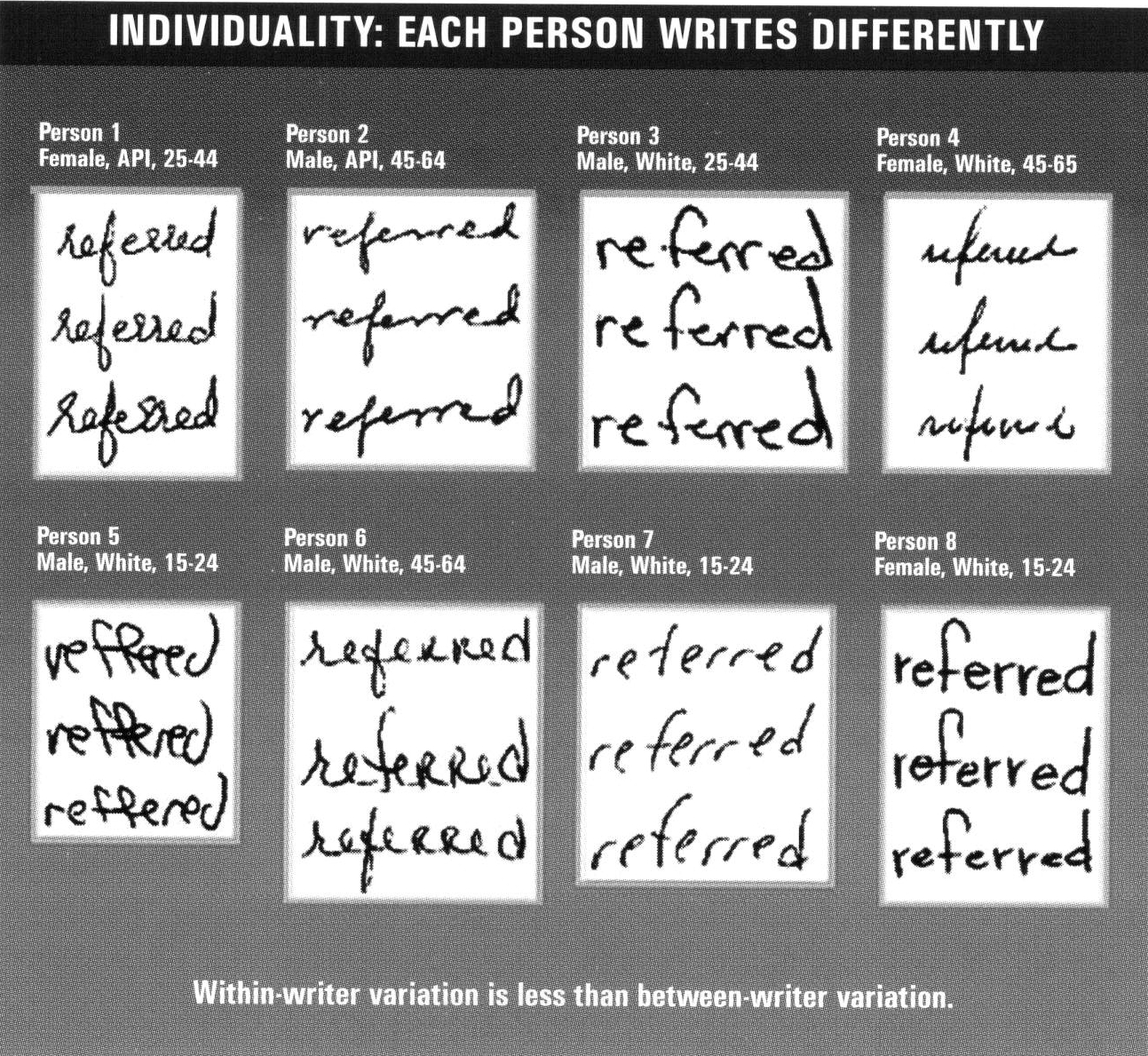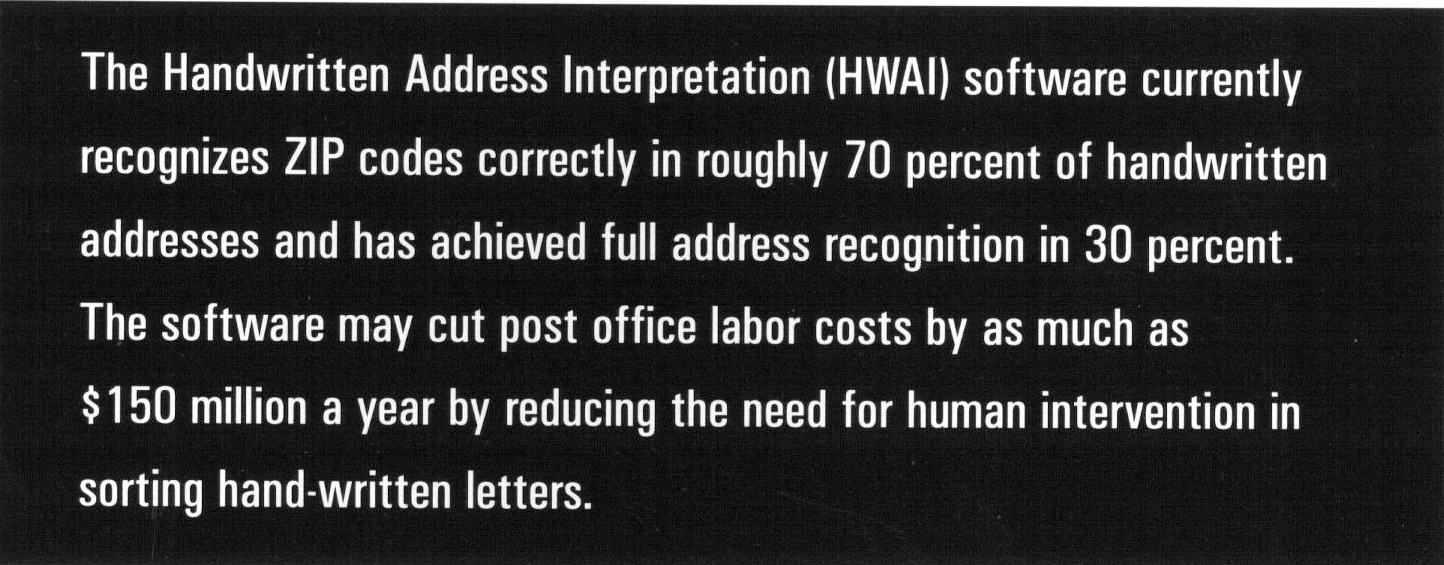
Write Stuff -
After decades of research, Sargur Srihari has created
a handwriting recognition software that is being used by the FBI to develop
analysis tools for forensic purposes.
by
Niraj Trivedi

NUTSHELL
- Srihari joins computer science faculty
at SUNY, Buffalo, in 1978. - Develops computer-aided handwriting
recognition software for mail sorting at
USPS. - Receives federal funding to develop
handwriting analysis tools for forensic
applications. - Co-founds CedarTech and Cymfony,
compainies aimed at market-driven
research in pattern recognition
technology.
Anyone who has ever tried to
decipher bad handwriting can understand why postal workers have a reputation
for inefficiency: They read some 50 million hand addressed envelopes a day, or
10 percent of the overall mail. Sargur Srihari, however, has eliminated that
frustrating and time‑consuming task once and for all.
Srihari, 52, director of the
Center of Excellence for Document Analysis and Recognition (Cedar) at the State
University of New York (SUNY) in Buffalo, has developed a handwriting
recognition computer program capable of culling useful information from
illegible addresses on letters.
Similar programs,
particularly the ones on tiny hand‑held computers and personal digital
assistants, have been around for a while, but they have the advantage of being
able to "feel" how each letter is formed on an electronic pad and to
learn an individual's hand‑writing style. Such software would be woefully
inadequate in untangling the typical envelope address, in which individual
characters are often illegible, if not dropped entirely.
"When I started on the
problem a decade ago," says Bangalore‑born Srihari, "nobody had
even thought of dealing with this."
Market‑driven
research was always high on Srihari's agenda. He began work on handwriting
analysis shortly after he arrived in the United States in 1970. A graduate of
the Indian Institute of Science in Bangalore, Srihari headed to Ohio State
University for a Ph.D. in computer and information science.
It was during this time that he
developed an interest in researching handwritten documents and commercializing
the applications.
He
wondered how people read newspapers, what captured their attention in a
tabloid, or how a reporter read his handwritten notes. A deeper understanding of
the processes behind these required some sort of analytical framework. And
Srihari was determined to create one.
After joining SUNY's
computer science department as a faculty member in 1978, Srihari helped found
Cedar, where he put together a research team that would study handwritten
documents using artificial intelligence and mechanical analysis.
En route to creating the
Handwritten Address Interpretation (HWAI) software, Srihari generated six
patents, authored 150 papers on text recognition and was inducted as a fellow
of the prestigious Institute of Electrical and Electronics Engineers (IEEE).
In 1983, the United States Postal
Service (USPS) and companies such as Lockheed Martin and Siemens who are postal
contractors, became interested in HWAI.
After funding the program's development
for more than 14 years, the USPS eventually ran a test deployment of the HWAI
software in 1999, and later installed it at 255 of its major processing centers
in the country.
 The HWAI
software currently recognizes ZIP codes correctly in roughly 70 percent of
handwritten addresses and has achieved full address recognition in 30 percent.
The HWAI
software currently recognizes ZIP codes correctly in roughly 70 percent of
handwritten addresses and has achieved full address recognition in 30 percent.
The system may cut post office
labor costs by as much as $150 million per year by reducing the need for human
intervention in sorting handwritten letters, according to Srihari.
At that rate, one year's
savings will easily justify the USPS's investment in Srihari's research.
Srihari also notes that the agency
had a billion‑dollar budget surplus in 1999. "We like to think that
about one tenth of that billion‑dollar surplus was our
contribution," he says.
How exactly does the software
function? It looks at the ZIP code on the envelope, accesses a database of
possible street names within that area and then compares that information with
the beginning of the handwritten street address.
For instance, if the program deciphers
from the ZIP code that the address on the letter is Camden, New Jersey, and it
can read only the first
four letters of the street name (CAMD), then it can
look up all possible street names that match and come up with Camden Court.
HWAI's uniqueness lies in its
ability to consider the overall shape of the word rather than deciphering one
character at a time. This has yielded significant information about cursive
writing, which has drawn the interest of the Justice Department and the Federal
Bureau of Investigation (FBI). The two have expressed interest in developing
computer‑assisted handwriting analysis tools for forensic applications.
Armed with a $428,000 grant
from the National Institute of Justice in Washington, D.C., Srihari and his
team are modifying the HWAI software. The ultimate aim is to be able to
provide foolproof analysis that can be used to support the testimony of
handwriting experts in courts.
Scientific tools, such as
those developed by Srihari, are considered essential for admitting handwriting
evidence in U.S. courts due to a number of recent rulings, including the Jon‑Benet
Ramsey case concerning expert testimony.
Though handwriting analysts
may be able to solve the question of who penned a ransom note or forged a
check, their testimony is not admissible as evidence in criminal cases. The
reason being that since they are human, they cannot claim complete objectivity.
 "A
human expert may put in his or her own bias unconsciously," explains
Srihari. "We have built the foundation for a handwriting analysis system
that will quantify performance and increase confidence in determining a
writer's identity."
"A
human expert may put in his or her own bias unconsciously," explains
Srihari. "We have built the foundation for a handwriting analysis system
that will quantify performance and increase confidence in determining a
writer's identity."
The software basically validates
individuality in writing. The idea that everyone's handwriting is different is
taken for granted. Srihari has developed purely scientific criteria for that
premise.
He has submitted a paper,
"Individuality of Handwriting" to the Journal of Forensic Sciences.
If accepted for publication, the paper will herald a new era in criminal cases,
as it will form the basis for admitting expert testimony on handwriting under
the so‑called Daubert guidelines set by the U.S. Supreme Court.
Srihari and his team
developed the software by first collecting a database of more than 1,000
samples of handwriting from a pool of individuals representing a microcosm of
the U.S. population in terms of gender, age and ethnicity.
Multiple samples of handwriting
were taken from subjects, who were asked to write the same series of sentences
in cursive.
Instead of analyzing the sentences
visually, the way a human would, Srihari explains, the researchers
deconstructed each sample, extracting features from the writing, such as the
shapes of individual characters, descenders, and the spaces between lines and
words.
The researchers then ran the samples
through their software program. "We tested the program by asking it to
determine which of two authors wrote a particular sample, based on measurable
features," recalls Srihari. "The program responded correctly 98
percent of the time."
Part of the software has been
developed at CedarTech, a spin-off from Cedar. "Not all work that needs
to be done in this area could be performed in a university setting,"
Srihari notes.
|
TARGETING THE GLOBAL MARKET Character recognition is expected to show up in
applications as diverse as combined cell phone/GPS products and sophisticated
mail sorting machines being developed to handle the growing number of
packages. According
to Sargur Srihari, director of the New York‑based Center of Excellence
for Document Analysis and Recognition, many companies are interested in both
online and offline character recognition. Online character recognition is the
process of analyzing a character even as it is being written. Microsoft
uses online character recognition in its Windows CE operating system.
Research in online character recognition is moving toward using contextual
information ‑ characters that come before and after ‑ to decipher
a given character or word. Srihari says that he believes companies like
Microsoft and Motorola would like to add that kind of capability to their
next generation hand‑held devices. Siemens
and IBM are interested in the development of offline character recognition
and document analysis technologies. Offline recognition is applied to
handwritten documents after they are written, and is used, for example, by
the United States Postal Service (USPS) to automate mail sorting. "There
is a growing need to automate mail sorting worldwide, particularly at post
offices where mail is sorted largely by hand," Srihari says. Currently,
the USPS is the only organization in the world that uses automated mail sorting
machines. Australia,
the United Kingdom and Canada all plan to move to automated sorting to cut
costs, which is expected to create a considerable market for mail sorting
equipment.. Srihari and his team are
currently developing handwriting recognition software for the United
Kingdom. |
Although
he believes in conducting research for its own sake ‑ that is, without
necessarily exploiting the findings for commercial purposes ‑ Srihari feels
that market‑driven research is far more satisfying because there is an
ultimate goal.
"Some of the end goals
are so challenging that it does not trivialize the science," he concedes.
It was to meet these
challenges head on that Srihari and his wife, Rohini, also a computer
scientist, co founded Cymfony, a software company specializing in information
extraction technology.
Despite years of research, Srihari
remains more of an educator than a scientist. He balances the day between his
teaching job and what he calls "serious" commercial research.
"Pattern recognition is going
to become a multibillion dollar industry and its applications are
innumerable," Srihari says. "We are just beginning to tap into this industry,
and this what drives me.